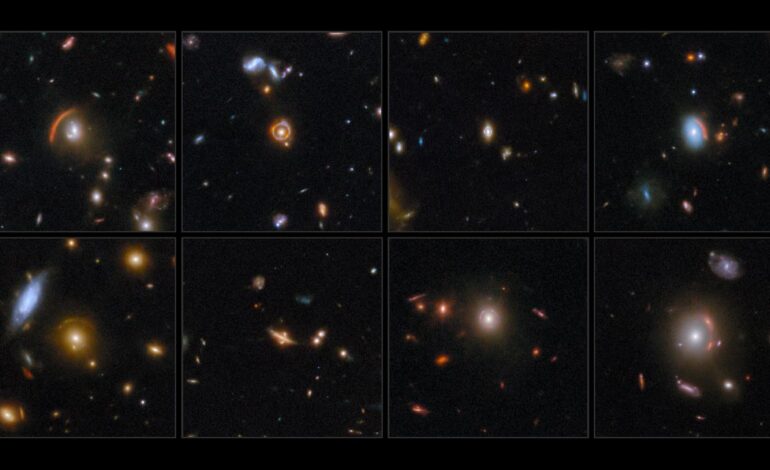James Webb Telescope Confirms Einstein’s Theory with Eight Stunning Images

The James Webb Space Telescope (JWST) has successfully confirmed Albert Einstein‘s theory of gravitational lensing, showcasing eight remarkable examples known as “Einstein rings.” Shared on September 30, 2025, these images reveal galaxies that appear stretched and warped, a phenomenon that allows scientists to observe distant cosmic formations with unprecedented clarity.
When massive galaxies sit within the fabric of space, they create a distortion that bends light from more distant objects. This effect, known as gravitational lensing, transforms these massive entities into natural magnifying glasses. The light from background galaxies is refracted, resulting in distorted arcs or complete rings, which are termed Einstein rings in honor of Einstein’s prediction over a century ago.
Unveiling the Cosmos Through Gravitational Lensing
The JWST’s latest findings come from an extensive project called COSMOS-Web, which involved over 255 hours of observation focused on more than 42,000 galaxies. During this time, researchers identified more than 400 potential Einstein rings, with the eight showcased being among the most striking. One of the highlights is the galaxy designated as COSJ100024+015334, which appears as a perfect circle. This galaxy existed when the universe was just one billion years old, a mere fraction of its current estimated age of more than 13 billion years.
The images captured by the JWST highlight the superior infrared capabilities of the telescope compared to its predecessor, the Hubble Space Telescope. While some of the galaxies were previously observed by Hubble, the new data reveals intricate details that were previously obscured. This includes galaxies that appear red due to dust and distance, providing a richer understanding of the cosmos.
Implications for Astronomical Research
Gravitational lensing not only allows astronomers to view distant galaxies but also enables them to measure the mass of these galaxies, including elusive dark matter that cannot be observed directly. The precise alignments that create Einstein rings serve as valuable tools for studying the fundamental components of galaxies, star clusters, and supernovae. These insights contribute significantly to our knowledge of how galaxies formed and the role dark matter played in shaping the universe in its early stages.
As astronomers continue to analyze these stunning images, the JWST’s findings promise to deepen our understanding of the universe and its history. The visual wonders captured by this state-of-the-art telescope provide a glimpse into the distant past, revealing how galaxies evolved over billions of years.
For those interested in more captivating space images, NASA’s archives offer a plethora of other breathtaking snapshots that further illustrate the beauty and complexity of our universe.






